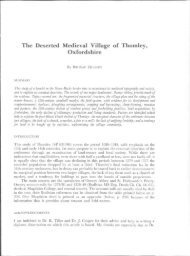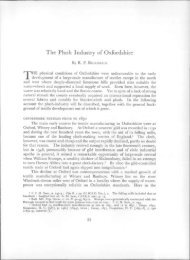The Fortunes of the Shrine of St. Mary of Caversham - Oxoniensia
The Fortunes of the Shrine of St. Mary of Caversham - Oxoniensia
The Fortunes of the Shrine of St. Mary of Caversham - Oxoniensia
You also want an ePaper? Increase the reach of your titles
YUMPU automatically turns print PDFs into web optimized ePapers that Google loves.
<strong>The</strong> <strong>Fortunes</strong> <strong>of</strong> <strong>the</strong> <strong>Shrine</strong> <strong>of</strong> <strong>St</strong>. <strong>Mary</strong> <strong>of</strong><br />
<strong>Caversham</strong><br />
By C. HAIGH and D. LoADES<br />
In Memory <strong>of</strong> H. Martin Gillett<br />
Some nine months bifore he died, <strong>the</strong> late Martin Gillett entrusted <strong>the</strong> authors <strong>of</strong> this short study with<br />
<strong>the</strong> materials which he had collected over many y,ars relating to <strong>the</strong> shrine <strong>of</strong> <strong>the</strong> Blessed Virgin, once<br />
situated in <strong>the</strong> village oj <strong>Caversham</strong> in south OxJordshire. I Mr. Gillett was a lifelong student <strong>of</strong> such<br />
shrines, and <strong>the</strong> author oj several books about <strong>the</strong>m. In 1957 he published his early findings about<br />
<strong>Caversham</strong> in <strong>Shrine</strong>s <strong>of</strong> Our Lady in England and Wales, pp 79-92. Continued investigation,<br />
had, however, convinced him <strong>of</strong> <strong>the</strong> inadequt1C)l <strong>of</strong> that account, and he very much wished it to be<br />
amplified and corTectd. <strong>The</strong> study which Jollows is, <strong>the</strong>rifore, written in accordance with his wishes,<br />
utilising his own notes and transcripts, toge<strong>the</strong>r with such additional material as <strong>the</strong> authors have been<br />
able to add from Iheir own researches. It does not claim to be dtjinitive, and is no doubt different in some<br />
respects Jrom that which Martin Gillett would himself hav, written, but it does add substantially to<br />
such o<strong>the</strong>r accounts <strong>of</strong> <strong>the</strong> shrine as art available in print. CavtTsham was a shrine which flourished<br />
bridly in <strong>the</strong> thirteenth century, when it attracted <strong>the</strong> patronage <strong>of</strong> Henry III. <strong>The</strong>reafter it gradually<br />
losl status, rtmaining popular as a local pilgrimage ctnire, but attracting ong small <strong>of</strong>ferings. Thir was<br />
aJate shared by many such centres in <strong>the</strong>fifteenth and sixteenth centuries, although shrines oJ<strong>the</strong> Blessed<br />
Virgin usually managed to pre<strong>St</strong>TUt <strong>the</strong>ir prestige rathtr betler than CavtTsham <strong>St</strong>ems to have done.<br />
O n<br />
17 September 1538 Dr. John London wrote from Reading, 'I have pulled down<br />
<strong>the</strong> Image OrOUf Lady at <strong>Caversham</strong>, whereunto was great pilgrimage . .. I have<br />
also pulled down <strong>the</strong> place she stood in with all o<strong>the</strong>r ceremonies, as lights, shrouds,<br />
crutches and images <strong>of</strong> wax hanging about <strong>the</strong> chapel and have defaced <strong>the</strong> same<br />
thoroughly as eschewing <strong>of</strong> any fur<strong>the</strong>r resort thi<strong>the</strong>r .. .', So successful was he that John<br />
Leland, passing that way not long after, commented upon <strong>the</strong> structure <strong>of</strong> <strong>Caversham</strong><br />
bridge and <strong>the</strong> chapel <strong>of</strong> Sl. Anne which it bore, but completely failed to mention <strong>the</strong><br />
proximity <strong>of</strong> <strong>the</strong> former shrine, which some had once thought to rival that at<br />
Walsingham.' Nor did any <strong>of</strong> <strong>the</strong> subsequent grants or leases, by means <strong>of</strong> which all <strong>the</strong><br />
land in and around <strong>the</strong> village changed hands between 1538 and 1560, so much as<br />
mention <strong>the</strong> site <strong>of</strong> <strong>the</strong> chapel. ot only has it totally disappeared, but no au<strong>the</strong>ntic<br />
memory <strong>of</strong> it seems to have been preserved, ei<strong>the</strong>r in <strong>the</strong> form <strong>of</strong>field or road names, or in<br />
tradition, and its location has confused local antiquarians. London may have exaggerated<br />
somewhat in order to emphasise <strong>the</strong> success <strong>of</strong> his mission, but Cromwell and <strong>the</strong> Council<br />
had many o<strong>the</strong>r sources <strong>of</strong> information and he could not safely have indulged his<br />
imagination. <strong>The</strong> shrine was real enough, and must have been very much as he described<br />
it in <strong>the</strong> three informative letters by which he recounted its destruction to differem<br />
parties, but its hjstory and status present a number <strong>of</strong> problems.<br />
I <strong>Caversham</strong> is now a part <strong>of</strong> Reading, but throughout <strong>the</strong> period with which this study is concerned it was<br />
in Oxfordshire, <strong>the</strong>: roumy ooudary between Oxfordshire and Berkshire running down <strong>the</strong> middlt: <strong>of</strong> <strong>the</strong> river.<br />
1 BL Couon MS Cleopatra E IV, f267, printed in T . Wright, Thrn Clwpkrs <strong>of</strong> uUers relating UJ <strong>the</strong><br />
Supprusioll oj <strong>the</strong> ."'[01UJSlniu, Camden Soc. XXVI, 221.<br />
) john Lewui's Itinerary, ed. L. Toulmin Smith ( 1910). part I I, pp.111-2.
70 c. HAIGH A.'1D D. LOADES<br />
chapel <strong>of</strong> SI. Anne. Eight years later, in <strong>the</strong> process <strong>of</strong> confirming <strong>the</strong> liberties <strong>of</strong> <strong>the</strong><br />
borough <strong>of</strong> Reading, Elizabeth granted <strong>the</strong> corporation <strong>the</strong> reversion <strong>of</strong> <strong>the</strong> chapel and<br />
meadow, describing it simply as 'Iatc in <strong>the</strong> tenure <strong>of</strong> William Penson, kt.'51 In most<br />
respects this Patent confirms <strong>the</strong> picture painted by <strong>the</strong> tenants <strong>of</strong> <strong>Caversham</strong>, but it also<br />
contains a grant to <strong>the</strong> town <strong>of</strong> 'Le Lytle Orte lands, <strong>the</strong> site <strong>of</strong> <strong>the</strong> Holy Ghost chapel at<br />
<strong>Caversham</strong> bridge, now destroyed'. Although it is not impossible, it seems unlikely that<br />
this description refers to <strong>the</strong> former shrine in <strong>Caversham</strong>. <strong>The</strong>re may well have been at<br />
one time ano<strong>the</strong>r chapel at <strong>the</strong> south end <strong>of</strong> <strong>the</strong> bridge, and occasional references to<br />
'chapels' in <strong>the</strong> plural also indicate thal this was so.<br />
Although <strong>the</strong> pattern becomes a litlie clearer on investigation, <strong>the</strong>refore, it is still not<br />
certain where <strong>the</strong> chapel <strong>of</strong> SI. <strong>Mary</strong> was situated. It was not adjacent to <strong>the</strong> parish<br />
church, nor was it between <strong>the</strong> church and <strong>the</strong> river, because that land, granted to <strong>St</strong>.<br />
Peter's by William Marshal, became part <strong>of</strong> <strong>the</strong> Rectory. It was, however, far enough<br />
from <strong>the</strong> Thames for <strong>the</strong> land between to be <strong>the</strong> subject <strong>of</strong> a separate grant, again by<br />
William Marshal; moreover, since <strong>the</strong> benefactor withheld <strong>the</strong> fishpond which was<br />
situated within <strong>the</strong> plot granted, its extent must have been considerable. n It is clear from<br />
a number <strong>of</strong> references that <strong>the</strong> chapel and <strong>the</strong> warden's house, with its garden and<br />
orchard were contiguous, and William Marshal's grant <strong>of</strong> 1215, which refers to buildings<br />
next to <strong>the</strong> north door <strong>of</strong> <strong>the</strong> chapel as well as to <strong>the</strong> east <strong>of</strong> <strong>the</strong> enclosure, suggests morc<br />
extensive accommodation. <strong>The</strong>re may, at one time, have been more than one canon<br />
serving <strong>the</strong> shrine. Henry Ill's grants are couched in various terms; twice he refers to <strong>the</strong><br />
'Canon custodian' in <strong>the</strong> singular (once by name); twice to '<strong>the</strong> canons <strong>of</strong> Nutley serving<br />
at <strong>Caversham</strong>', and once to '<strong>the</strong> Prior <strong>of</strong> <strong>Caversham</strong>'.'l <strong>The</strong>re was certainly never a<br />
proper Priory at <strong>Caversham</strong>, but <strong>the</strong>re may, at least for a time, have been a cell which<br />
was accorded that courtesy title. If that was so, <strong>the</strong>n <strong>the</strong> memory <strong>of</strong> <strong>the</strong> site may have<br />
been preserved in <strong>the</strong> building which still appeared with that name on <strong>the</strong> six-inch<br />
ordnance survey map, about a quarter <strong>of</strong> a mile north east <strong>of</strong> <strong>the</strong> north end <strong>of</strong> <strong>the</strong> bridge.<br />
Such a location would be consistent with most <strong>of</strong> <strong>the</strong> scrappy evidence which has<br />
survived. William Marshal's fishpond could have been situated east <strong>of</strong> <strong>the</strong> bridge, and<br />
Walter de Hyde's 9 acres 'between <strong>the</strong> green and <strong>the</strong> road to Wallingford' would have<br />
been west <strong>of</strong> <strong>the</strong> chapel and north <strong>of</strong> <strong>the</strong> village centre. Also, if <strong>the</strong> chapel had been on <strong>the</strong><br />
fringe <strong>of</strong> <strong>the</strong> village, or outside it, London might have had some justification for<br />
describing it as 'lying wildly'. On <strong>the</strong> o<strong>the</strong>r hand, such a situation makes it hard to see<br />
why a boat was necessary, as late as 1239, to bring pilgrims to <strong>the</strong> shrine when <strong>the</strong> bridge<br />
had been built in roughly its present position between 1200 and 1219." Responsibility for<br />
maintaining <strong>the</strong> bridge was divided between <strong>the</strong> abbeys <strong>of</strong> Reading and Nutley, so it<br />
seems unlikely that <strong>the</strong> pilgrims would have been driven by tolls to seek an alternative.<br />
Never<strong>the</strong>less a ferry <strong>of</strong> some kind was still functioning in <strong>the</strong> sixteenth century, and a<br />
'ferry and ferry barge' were included in <strong>the</strong> particulars <strong>of</strong> Francis Knollys' lease <strong>of</strong> <strong>the</strong><br />
manor in 1542." If <strong>the</strong> shrine had lain close to <strong>the</strong> river upstream <strong>of</strong> <strong>the</strong> bridge, a ferry<br />
would have been more convenient and direct, but thal does not fit any o<strong>the</strong>r description.<br />
I t is possible that <strong>the</strong> ferry crossed downstream <strong>of</strong> <strong>the</strong> eyot, which would have been closer<br />
5' Cal.Pat. Elrz.., vol. I. p.283.<br />
51 Ch.Ch., Nutlq roll, 3, 3.<br />
51 Clost Rolls, 1242-1247, p.393.<br />
So6 Clost Rolls, 1237-1242, p.loa.<br />
SJ LAttns and papns, vol. XVII, p.636.













